Meeting: December 10, 2019
|
Called
“Old Pete” and “My Old War Horse” by Gen. Robert
E. Lee,
Lt. Gen. James Longstreet was
Lee’s trusted advisor and friend. However,
his letters to the New Orleans Times, his
support of the Republican Party, and his memoirs
served to alienate many Southerners, especially
among the early “Lost Cause” folk lead by Gen.
Jubal Early and others. Those attacks continue
in 2019. A large portion of those attacks focus
on how
Longstreet handled
his corps at the July, 1863 battle of Gettysburg
(Pa.).
Local
American History author
Cory M. Pfarr address
battle and the controversy as he talks about his
latest work
Longstreet at Gettysburg: A Critical
Reassessment at
the next BCWRT meeting on Tuesday, December 10
at 7:30 p.m.
Cory M. Pfarr works
for the Department of Defense and is an American
History author whose main interests span
America's Revolutionary to Civil War years. His
work on John Quincy Adams,
"John Quincy Adams's Republicanism: 'A Thousand
Obstacles Apparently Stand Before Us'"
was published by the Massachusetts Historical
Society in 2014. His book-length study on
Lieutenant General James Longstreet's performance
at the Battle of Gettysburg, titled, Longstreet
at Gettysburg: A Critical Reassessment, was
published by McFarland in 2019. He has also
written articles for “North & South” and
“Gettysburg Magazine”, and has appeared on the
Pennsylvania Cable Network and C-SPAN American
History TV. He lives in Pikesville, Maryland
with his wife and three kids.
Notes from the President December 2019
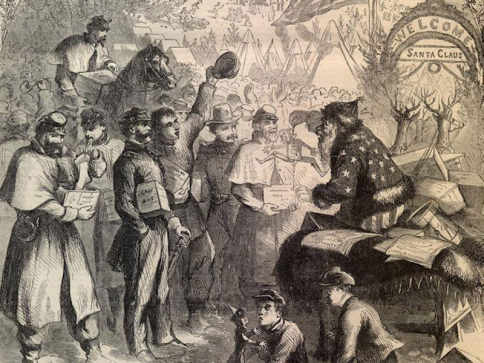
It was Civil War era cartoonist Thomas Nast who
gave us what is considered the modern image of
Santa Claus in the January 3, 1863 issue of
Harper’s Weekly (see more in the Articles
Section). On behalf of our Board, I wish you all
a Happy and Blessed Holiday Season! Whether you
celebrate Christmas, Chanukah (Hanukkah),
Ashura, Bodhi Day, Kwanza or any other festival
of note, May Peace Be With You All!
It’s been less than two weeks since our last
meeting; therefore, there aren’t many updates.
We are still working to complete our
arrangements for our Annual Banquet in April,
which will again we held at Columbus Gardens on
April 28, 2020. Working with the Chesapeake
Civil War Roundtable, we will provide detailed
information as soon as our speaker is confirmed.
Remember,
it’s time to renew your membership for 2020!
Local American History author Cory M. Pfarr will
reflect on his latest work
Longstreet at Gettysburg: A Critical
Reassessment
during our meeting on December 10.
We’ll start 2020 on January 28 when Author,
historian, preservationist and NPS battlefield
Guide Matt Borders will take a look at the
“Spy Game in Maryland” during
the Civil War.
Dr.
Karsonya (Dr. Kaye) Wise Whitehead, Associate
Professor of Communication and African and
African American Studies in the Department of
Communication at Loyola University Maryland,
will talk about her book;
Notes from a Colored Girl: The Civil War Pocket
Diaries of Emilie Frances Davis.
This is our
February 28 meeting.
Author, re-enactor and attorney Bernie Siler
returns to the BCWRT to discuss his Brightwood
section of D. C. (Fort Stevens) related book;
A Tale of Two Centuries.
This will occur during our meeting on March 24.
Will are again working with the Chesapeake Civil
War Roundtable to present our Annual Banquet on
April 28 at the Columbus Gardens. Stay tune for
further announcements.
On May 26 Award winning author William Connery
returns to present a talk on career of CSA
Secretary of the Navy Stephen R. Mallory.
On June 23, Author and lecturer Timothy Lloyd
Tilghman will address the topic
“Maryland during the Civil War”.
Annette T. Khawane, Adjunct
Professor of Mortuary Sciences at Catonsville
Community College, returns to focus on
“Funeral Practices during the Civil War” at
our meeting on
July 28:
August 25 will see author Ron Kirkland focus on
the immediate results of war on those who fight
as he presents;
Too Much for Human Endurance. The George
Spangler Farm Hospital at the Battle of
Gettysburg.
Reminder: Membership has it’s privileges…and
joys. Urge your friends to join the Baltimore
Civil War Roundtable. Also, renew
you membership if you haven’t already paid your
annual dues.
|
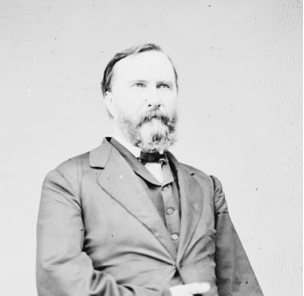
James Longstreet

Cory M. Pfarr
Our December meeting was our 430th. Our attendance was 12, and
we had two visitors. As of December 10, our membership was 29
(officially it was 30, but this included Walter Price, who sadly
passed away). We had a net $1,569.23 in the bank ($2,069.23
minus a $500 check to be written for our Annual Banquet). There
was no money to be deposited, and no outstanding bills. Our
future bills were for speakers and the banquet. The treasurer’s
report noted that we will probably have to pay the Parkville
Recreation Council a fee for using the meeting hall in 2020. On
November 14, 2017, we paid $385 for 55 members--$7 per member.
Our speaker was Cory Pfarr. Mr. Pfarr spoke on the performance
of Confederate General James Longstreet, commanded of the First
Corps of the Army of Northern Virginia, at the battle of
Gettysburg. He is the author of
Longstreet at Gettysburg: A Critical Reassessment.
Longstreet has been heavily criticized over the decades for his
actions at Gettysburg. Mr. Pfarr argued that the criticisms
have been undeserved. The reasons for them, he said, have had
little to do with Longstreet’s generalship and much to do with
postwar events. After the war, Longstreet became a Republican,
and a friend and political ally of U.S. Grant. He supported--at
least to an extent--voting rights for African Americans. And he
criticized Robert E. Lee. These things made him anathema to
Jubal Early and others who promoted the “Lost Cause”
interpretation of the war, and they used him as a scapegoat for
the Confederate defeat at Gettysburg. Because of their
influence, historians have been largely critical of Longstreet
since.
Mr. Pfarr attacked what he considers myths regarding
Longstreet’s conduct at Gettysburg. Contrary to popular belief,
he was not slow to arrive on the battlefield. Lee did not plan
a “sunrise attack” on the morning of July 2. This was a myth
propagated by Early and William Pendleton. During the night of
July 1-2, Lee was undecided concerning what to do with Ewell’s
Second Corps. It wasn’t until the late morning of July 2 that
Lee decided to keep Ewell where he was. Lee decided that Ewell
was to launch an attack at the same time as Longstreet. Ewell
didn’t do this, and Lee didn’t check on him to see if he was
complying.
Longstreet was not sluggish in initiating his attack on July 2.
There were reconnaissance missions that continued until
mid-afternoon, as well as a countermarch from noon to 3 pm.
Moreover, Mr. Pfarr argued, how would an earlier attack have
done any good, given not merely the missions and countermarch,
but also the fact that the Union line on Cemetery Ridge was
already well formed? Also contrary to Longstreet’s critics,
Little Round Top was not the objective on the 2nd. Instead, Lee
wanted an attack up the Emmitsburg Road. He intended to seize
the Sherfy Peach Orchard as a springboard to attack Cemetery
Ridge and Cemetery Hill. Additionally, during the night of July
2-3, Longstreet did not get any orders for a new attack over the
same ground as he attacked on the 2nd. He was not responsible
for delaying the Pickett-Pettigrew-Trimble attack on the 3rd.
Mr. Pfarr also pointed out that Lee and Longstreet continued to
have an excellent relationship. Lee never once criticized
Longstreet before dying in 1870. If Longstreet had indeed
performed poorly at Gettysburg, why would this have been the
case?
|
Meeting: November 26, 2019
|
Albert G. Hills
was a young man from Massachusetts who tried a
number of occupations in the antebellum period
before settling on journalistic endeavors. A
Republican, he took a job as a war correspondent
for the
Boston Journal newspaper,
attached to the army-navy expedition targeting
New Orleans. After reporting on the fall of the
Crescent City in 1862, he partnered in the
operation of a new Unionist newspaper in the
city, the
Era.
Hills even
joined the army in 1863, commissioned a
lieutenant in the 4th Louisiana Native Guards,
only serving three months before resigning and
returning to his prior vocation.
The
three 1861-63 journals that
Hills kept
comprise the heart of
A Civil War Correspondent in New Orleans.
Beginning in November 1861, Hill describes the
outfitting of the New Orleans expedition and its
travels to the Gulf of Mexico. In addition to
covering the occupation of Ship Island and the
early blockade of the Mississippi River mouth,
Hill recounts several side expeditions to the
Alabama and Florida coasts. He must have
cultivated a vast array of relationships with
army and navy officers, as he traveled from the
ship to ship (seemingly at will) and was privy
to planning at a level disturbing to operational
security.
Frederick County CWRT Secretary and owner of
Dyson Genealogy
and Historical Research
Gary L. Dyson returns
to the Baltimore Civil War Roundtable to discuss
Hills’ journal which he has edited. Mr.
Dyson will
be with us on Tuesday, November 26, 2019 at 7:30
p.m.
Gary L. Dyson is
a retired Environmental Specialist from the city
of Gaithersburg, MD and a former Marine. He is a
lifelong history enthusiast and has spent
countless hours reading, researching and
exploring battlefields – from the French and
Indian War to World War II. Gary owns Dyson
Genealogy and Historical Research and is the
author of
“Ambush of the Isaac P. Smith” and
“A Civil War Correspondent in New Orleans, the
Journals and Reports of Albert Gaius Hills of
the Boston Journal.”
He has a BS in Natural Resources Management from
Oregon State University.
Notes from the President November 2019
It seems as though winter has come early this year. Can
you imagine being a soldier trying to exist in
the field while dealing with these weather
elements? Fortunately, for some armies, the
fighting would basically stop as enemy
combatants settled into ‘winter quarters’. We
hope that the changes in this unpredictable
early season has little to no effect on our
meetings. Email notices will be sent in case of
inclement weather.
On November 26, Frederick County CWRT Secretary and owner
of Dyson Genealogy and Historical Research Gary
L. Dyson returns to BCWRT to discuss his book
"A Civil War Correspondent in New Orleans".
In this book, Mr. Dyson has edited the journals
of Boston Journal correspondent Albert Gaius
Hill as he covered the New Orleans campaign of
1862.
Local American History author Cory M. Pfarr will reflect
on his latest work Longstreet at Gettysburg: A
Critical Reassessment during our meeting on
December 10.
We’ll start 2020 on January 28 when Author,
historian, preservationist and NPS battlefield
Guide Matt Borders will take a look at the “Spy
Game in Maryland” during the Civil War.
Dr.
Karsonya (Dr. Kaye) Wise Whitehead, Associate Professor of
Communication and African and African American
Studies in the Department of Communication at
Loyola University Maryland, will talk about her
book;
Notes from a Colored Girl: The Civil War
Pocket Diaries of Emilie Frances Davis. This is our
February 28 meeting.
Author, re-enactor and attorney Bernie Siler
returns to the BCWRT to discuss his Brightwood
section of D. C. (Fort Stevens) related book;
A Tale of Two Centuries.
This will occur during our meeting on March 24.
Will are again working with the Chesapeake Civil
War Roundtable to present our Annual Banquet on
April 28 at the Columbus Gardens. Stay tune for
further announcements.
On May 26 Award winning author William Connery
returns to present a talk on career of CSA
Secretary of the Navy Stephen R. Mallory.
On June 23, Author and lecturer Timothy Lloyd
Tilghman will address the topic “Maryland during
the Civil War”.
Annette T. Khawane, Adjunct Professor of Mortuary Sciences at Catonsville
Community College, returns to focus on “Funeral
Practices during the Civil War” at our meeting
on
July 28:
Reminder: Membership has it’s
privileges…and joys. Urge your friends to join
the Baltimore Civil War Roundtable. Also, renew you membership if you haven’t already paid your
annual dues.
|

Minutes -
Our November meeting was our 429th. Our attendance was 11.
There was no treasurer’s report. We discussed next year’s
annual banquet, and agreed to make a $500 deposit.
Our speaker was Gary Dyson. Mr. Dyson spoke about his book
entitled
A Civil War Correspondent in New Orleans: The Journals and
Reports of Albert Gaius Hills of the Boston Journal.
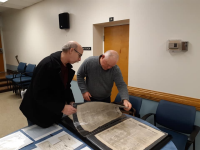 Click to enlarge
Click to enlarge
Hills was born in Massachusetts in 1829. As a young man, he was
a sailor and (like his father) a pattern maker before becoming a
reporter for the
Journal.
During the Civil War he served as a war correspondent. On his
first expedition, he went to Fort Monroe (stopping in Baltimore
on the way) and finally (on December 12, 1861) to Ship Island.
Hills wrote a number of personal journal entries that vividly
describe life on the island. He did not stay there,
however--he went from one ship to the next, visiting Havana and
Key West.
Hills’ journals are an immensely valuable source for information
concerning the Union campaign up the Mississippi River to
capture New Orleans. The original plan included capturing Forts
Jackson and St. Philip. Both forts, although not destroyed,
were subjected to heavy bombardment. The Confederate gunners
were inexperienced, and the water level was up to the banks,
allowing the Union forces to fire back at them. So much fire
rained down on the Confederate gun crews that they couldn’t
operate the guns. In the end, the forts were bypassed. The
Confederate Navy was wiped out, while the Union lost only one
ship.
On May 1, New Orleans surrendered. It’s unclear whether Hills
actually went ashore after the city fell. The crowd was very
hostile. Hills boarded the USS
Rhode Island
to return to Fort Monroe. In November 1862, he returned to New
Orleans on the
North Star.
He stayed at the St. Charles Hotel. In addition to serving as
a base of operations for the correspondent corps, the hotel was
also the headquarters of the Department of the Gulf. Hills
became an editor of the
Era,
a pro-Union New Orleans newspaper. He was commissioned a 1st
Lieutenant in the 4th Louisiana Native Guards (later renamed the
76th USCT), an African American regiment, but resigned three
months later. Back at the
Era,
he was supportive of Michael Hahn, helping to elect Hahn as a
pro-Union governor of Louisiana. He left the
Era
in March 1864.
In addition to his own journals, Hills amassed a remarkable
collection of newspapers, documents, and memorabilia related to
the war, particularly from the Confederate side. These included
a copy of the Confederate constitution, as well as relics from
Ft. Jackson.
Hills’ journals abruptly stop in early 1863. His wife being
with him was probably a factor. At some point--probably in
1864--he returned to Boston. He may have subsequently started a
turpentine business in New Bern, N.C. He traveled to Europe,
selling a portrait based on William E. Marshall’s engraving of
Lincoln. In 1867, he reported on Franco-German relations
(before the Franco-Prussian War of 1870-71). Hills returned to
the
Boston Journal
as an agricultural reporter. He died in 1879 of Bright’s
disease (nephritis), and is buried in Cambridge, MA.
|
Meeting: October 22, 2019
|
George Washington Gayle is
not a name known to history. But it soon will
be. Forget what you thought you knew about why
Abraham Lincoln was assassinated by John Wilkes
Booth. No, it was not mere sectional hatred,
Booth’s desire to become famous, Lincoln’s
advocacy of black suffrage, or a plot
masterminded by Jefferson Davis to win the war
by crippling the Federal government.
Christopher Lyle McIlwain, Sr.’s The
Million-Dollar Man Who Helped Kill a President:
George Washington Gayle and the Assassination of
Abraham Lincoln exposes
the fallacies regarding each of those theories
and reveals both the mastermind behind the plot,
and its true motivation.
Mr. Mcllwain, Sr.
will talk about his book during the October 22,
2019 meeting of the Baltimore Civil War
Roundtable. The meeting begins at 7:30 p.m.
Using electronic media, he will be speaking from
his home Alabama while informing us that the
deadly scheme to kill Lincoln, Vice President
Andrew Johnson, and Secretary of State William
Seward was Gayle’s brainchild. The assassins
were motivated by money Gayle raised. Lots of
money. $20,000,000 in today’s value.
Christopher Lyle McIlwain, Sr.,
has been practicing law for more than three
decades in Tuscaloosa, Alabama. His other
passion is the study of nineteenth century
history. He is the author of two previous books,
Civil War Alabama (U. of Alabama Press, 2016),
the winner of the McMillan Prize, and 1865
Alabama: From Civil War to Uncivil Peace (U. of
Alabama Press, 2017). Chris has also published
several articles in a variety of history
journals.
Notes from the President October 2019
Future meetings of the BCWRT will have a deep
void with the passing of Walter Price. Walter,
who served as our Assistant Secretary/Treasurer,
joined the ancestors on October 17, 2019. The
Navy veteran spend 26 years as a member of the
Baltimore Police Department. In addition to the
BCWRT, Walter was a member of the Maryland
Historical Society, served as a Gettysburg
Battlefield guide and was an Oak Grove Baptist
Church Deacon. He was 79.
A change for our October 22 meeting. Christopher
Lyle McIlwain, Sr, will make a presentation on
his book The Million-Dollar Man Who Helped Kill
a President: George Washington Gayle and the
Assassination of Abraham Lincoln. This will be
done by electronic media.
On November 26, Frederick County CWRT
Secretary and owner of Dyson Genealogy and
Historical Research Gary L. Dyson returns to
BCWRT to discuss his book "A Civil War
Correspondent in New Orleans". The book tells
the story of Boston Journal correspondent Albert
Gaius Hill as he covered the New Orleans
campaign of 1862.
Local American History author Cory M. Pfarr
will reflect on his latest work Longstreet at
Gettysburg: A Critical Reassessment during our
meeting on December 10.
We’ll start 2020 on January 28 when Author,
historian, preservationist and NPS battlefield
Guide Matt Borders will take a look at the “Spy
Game in Maryland” during the Civil War.
Dr.
Karsonya (Dr. Kaye) Wise Whitehead, Associate
Professor of Communication and African and
African American Studies in the Department of
Communication at Loyola University Maryland,
will talk about her book;
Notes from a Colored Girl: The Civil War Pocket
Diaries of Emilie Frances Davis.
This is our
February 28 meeting.
Author, re-enactor and attorney Bernie Siler
returns to the BCWRT to discuss his Brightwood
section of D. C. (Fort Stevens) related book;
A Tale of Two Centuries.
This will occur during our meeting on March 24.
Will are again working with the Chesapeake
Civil War Roundtable to present our Annual
Banquet on April 28. Stay tune for further
announcements.
On May 26 Award winning author William
Connery returns to present a talk on career of
CSA Secretary of the Navy Stephen R. Mallory.
On June 23, Author and lecturer Timothy
Lloyd Tilghman will address the topic “Maryland
during the Civil
War”.
Reminder: Membership has it’s privileges…and
joys. Urge your friends to join the Baltimore
Civil War Roundtable. Also, renew
you membership if you haven’t already paid your
annual dues.
|
 
|
Meeting: September 24, 2019
|
The April 1965 issue of "Civil War Times
Illustrated" contained a "Special Report". Three
Frederick Maryland street views appeared.
Previously unpublished photographs showing two
of Union troops on parade and one presenting
Confederate soldiers on the march, created a
sensation among the world of civil war buffs and
historians. No known photographs showing
Confederate soldiers armed and on an active
campaign where then known to have existed, yet
100 years later on the anniversary of the end of
the conflict, one amazingly arrived. In 1965 the
information about the photo's was presented to
the public as it was then known, or was it? Now
more than 50 years hence, investigators
Paul Bolcik and Erik Davis, (members
of the Center for Civil War Photography) have
uncovered the the truth behind the photo's and
the full story, de bunking some of the "myth's"
created about them. Their findings about the
three photos have appeared in three magazine
stories and a "Washington Post" newspaper "John
Kelley's Washington" column from June 6, 2018.
Paul Bolcik and Erik Davis will
present their findings in
"Frederick, MD and its
Famous Confederate Photo"
during the September 24, 2019 meeting of the
Baltimore Civil War Roundtable at 7:30 p.m.
They will present their methods and fact finding
study in an excellent power point presentation,
focusing on the
famous Confederate Frederick, MD photo, yet
also details the "then and now" of Frederick
during the war and it's aftermath.
Paul Bolcik is a founding member of the
Montgomery Co. MD. Civil War round table from
Oct. 1980. His writings photographs and
investigations have appeared in LIFE magazine,
Civil War Times, Civil War News, Military Images
Magazine, The Daguerreian Society's annual
yearbook and quarterlies, The Jonestown annual
report and Spokes (a Frederick, MD. based
cycling newspaper for the mid-Atlantic states).
Erik Davis has been a digital cartographer for
30 years, he resides in Frederick with his wife
and son. His investigations and photographs have
appeared in The Washington Post, The Civil War
Monitor Magazine, Frederick Magazine,
Battlefield Photographer Magazine and the
Montgomery Journal.
Notes from the President September 2019
In August, via our speaker Alann D. Schmidt, our focus was
on the famous Dunker Church located on the Antietam battlefield.
This month we continue focusing on the Civil War in Western
Maryland. Many people are familiar with the highly circulated
picture of CSA soldiers marching through Frederick, Maryland
circa July, 1864. Our September 24 meeting features Civil War
photography researchers Erik Davis and Paul Bolcik will present
their modern research on "Frederick, MD and its famous
Confederate photo".
Our October 22 meeting has BCWRT President Robert L. Ford
conducting a presentation on Christopher Lyle McIlwain, Sr,’s
book The Million-Dollar Man Who Helped Kill a President: George
Washington Gayle and the Assassination of Abraham Lincoln.
On November 26, Frederick County CWRT Secretary and owner
of Dyson Genealogy and Historical Research Gary L. Dyson returns
to BCWRT to discuss his book "A Civil War Correspondent in
New Orleans". The book tells the story of Boston Journal
correspondent Albert Gaius Hill as he covered the New Orleans
campaign of 1862.
Local American History author Cory M. Pfarr will reflect
on his latest work Longstreet at Gettysburg: A Critical
Reassessment during our meeting on December 10.
We’ll start 2020 on January 28 when Author,
historian, preservationist and NPS battlefield Guide Matt
Borders will take a look at the “Spy Game in Maryland” during
the Civil War.
Our February 28 speaker is still being confirmed.
Author, re-enactor and attorney Bernie Siler returns to the
BCWRT to discuss his Brightwood section of D. C. (Fort Stevens)
related book;
A Tale of Two Centuries.
This will occur during our meeting on March 24.
Will are again working with the Chesapeake Civil War Roundtable
to present our Annual Banquet on April 28. Stay tune for further
announcements.
On May 26 Award winning author William Connery returns to
present a talk on career of CSA Secretary of the Navy Stephen R.
Mallory.
Reminder: Membership has it’s
privileges…and joys. Urge your friends to join the Baltimore
Civil War Roundtable. Also, renew you membership if you haven’t already paid your
annual dues.
|


Minutes
Our September meeting was our 427th. Our attendance was 19, and we had two visitors. As of
September 24, we had $2,134.23 in the bank, and no money to be
deposited. Our membership was 30.
Our speakers were Paul Bolcik and Eric Davis, members of
the Center for Civil War Photography. Although Mr. Bolcik and
Mr. Davis discussed a total of three photos, their focus was a
famous photo which shows Confederate soldiers—members of the
Army of Northern Virginia--on a street in Frederick, Maryland.
This is the only known photograph of Confederates on campaign.
Although Civil War histories have traditionally said that it
was taken during the 1862 Maryland campaign, Mr. Bolcik and Mr.
Davis argued that the photo was probably actually taken on July
9, 1864—the same day as the battle of Monocacy.
In their investigation of the photo, the two men performed
extensive detective work using a variety of methods and sources.
They examined old newspaper articles, deeds, and other photos.
They also performed an in-depth analysis of the photo, zeroing
in on small details as clues. The evidence, in their view,
consistently points to the photo being from 1864 rather than
1862.
The photo contains a sign for the store of Joseph
Rosenstock. Rosenstock opened his store in 1860, and historians
had long been mistaken concerning its location. This was an
important factor in concluding that the photo had been taken in
1862. Rosenstock was arrested in August 1864 for selling
clothes to Union troops. Additionally, three Union soldiers
robbed him in March 1865.
Mr. Bolcik and Mr. Davis managed to deduce the location
where the photo was taken—the photographic studio of Jacob
Byerly. If the photo was taken in 1862, Confederate troops
would not have been passing by Byerly’s studio—none are known to
have traveled by that route at the time.
In addition to problems with locations, Mr. Bolcik and Mr.
Davis pointed to numerous other details of the photo which
indicate a date of 1864. For example, there is a dark area
under the “Rosenstock Sign” suggesting recent rainfall. While
there was rain in Frederick on September 1, 1862, this was five
days before the Confederates arrived. From that time, it was
sunny until September 11, when D.H. Hill’s men became the last
Confederates to march through Frederick during only light rain.
However, there was more substantial rainfall on the night of
July 8-9, 1864. Another clue is that all three of Frederick’s
newspapers reported that civilians turned out in large numbers
to see the Confederates who came through in 1862. However,
there are no civilians in the photo. Additionally, the photo
shows Confederate troops stuck in a “traffic jam” rather than
marching. No problems of this sort were reported in 1862.
However, on the morning of July 9 a jam DID exist in Frederick.
Confederate troops under John Echols had been ordered to find
the banks, depots, and other supplies. They ended up colliding
with Jubal Early’s wagon train.
Mr. Bolcik and Mr. Davis concluded by discussing how they
managed to take a photo of the same spot in present-day
Frederick captured in the Confederate photo, and subsequently
superimpose the old photo onto the new one. Given that Byerly’s
studio is now a private residence, the men were unable to take a
new photo from there. To take one from a similar height and
angle required a lot of ingenuity, persistence, and
technological know-how.
|
|
|
Meeting: August 27, 2019
|
The
most recognizable feature of the Antietam
Battlefield is the
Dunker Church.
One of the least known about and least studied
aspects of Antietam is the
Dunker Church…….who
were they, how did they happen to be there, what
happened after the battle and the war?
Alann Schmidt and Terry Barkley have
collaborated to produce a book that answers
those questions and more-
September Mourn: The Dunker Church of Antietam.
Both authors will speak with the Baltimore Civil
War Roundtable at our next meeting on Tuesday,
August 27, 2019 at 7:30 p.m.
Alann
Schmidt spent
fifteen years as a park ranger at Antietam
National Battlefield and presented hundreds of
programs on the
Dunker Church to
park visitors, Civil War seminars, community
groups, churches, and Brethren Heritage tours.
Alann earned degrees from the University of
Pittsburgh, Shippensburg University, Shepherd
University, and the Pittsburgh Institute of
Mortuary Science. While illness forced him into
early retirement, he still serves as a pastor
for the Churches of God and helps foster pets
for rescue groups. He and his wife Tracy (and
their many cats) live on their family farm near
Fort Littleton, Pennsylvania.
A member of
the Thoreau Society,
Terry Barkley is
a retired professional librarian, archivist, and
Harvard-trained museum curator, and a former
history teacher. He is the author of three books
and co-author of a fourth. His articles have
appeared in the Tennessee Historical Quarterly,
Living Blues, and in The Brethren Encyclopedia.
Terry is currently chair of the Brethren
Historical Committee of the
Church of the Brethren (Dunkers).
He is an independent scholar and musician who
lives in Lexington, Virginia.
Notes from the President August 2019
Last month I spoke about the July heat and how the Civil
War warriors had to endure the weather while
wearing wool from head to toe. Well, after a
record breaking July, August hasn’t gotten that
much better. On a recent HOT Saturday, I spent
the day in re-enactment garb at the Allstadt
Corner dedication in Harpers Ferry (See August
news articles), followed by a parade in Charles
town ending with a stop at the Antietam
Battlefield. It can be body-warming to study the
Civil War.
Most CW enthusiast know there is a Dunker church on the
Antietam battlefield. Few know anything about
the history of the church and their members. Authors
Alann D. Schmidt and Terry W. Barkley will
alleviate that situation as they discuss their
new book;
September Mourn: The Dunker Church of Antietam.
This will be our August 27 meeting.
Staying with the Civil War in Western Maryland: Many people are familiar with the highly circulated
picture of CSA soldiers marching through
Frederick, Maryland circa July, 1864. Our
September 24 meeting features Civil War
photography researchers Erik Davis and Paul
Bolcik will present their modern research on
"Frederick, MD and its famous
Confederate photo".
Our October 22 meeting has BCWRT President Robert L. Ford conducting a presentation
on Christopher Lyle McIlwain, Sr,’s book
The Million-Dollar Man Who Helped Kill a
President: George Washington Gayle and the
Assassination of Abraham Lincoln.
On November 26, Frederick County CWRT Secretary and owner of Dyson Genealogy and Historical Research
Gary L. Dyson returns to BCWRT to discuss his
book "A Civil War Correspondent in New
Orleans". The book tells the story of Boston Journal
correspondent Albert Gaius Hill as he covered
the New Orleans campaign of 1862.
Local
American History author Cory M. Pfarr will reflect on his
latest work
Longstreet at Gettysburg: A Critical Reassessment during
our meeting on December 10.
Please look at the Calendar of Events link to
see a partial schedule for 2020.
Reminder: Membership has it’s
privileges…and joys. Urge your friends to join
the Baltimore Civil War Roundtable. Also, renew you membership if you haven’t already paid your
annual dues.
|


Alann Schmidt

Terry
Barkley
Minutes
Our August meeting was our 426th. As of August 27th, we had $2,249.23 in the bank and no money to be
deposited. The only outstanding bill was for the speaker. Our
membership was 30. Attendance was 20, and there were two guests
present.
Our speaker was Alann Schmidt. A pastor for the Churches
of God who served as a park ranger at Antietam National
Battlefield for fifteen years, Mr. Schmidt discussed the history
of the Dunker Church. He and Terry Barkley are the authors of
the book
September Mourn: The Dunker Church of
Antietam Battlefield.
Mr. Schmidt began by discussing the origins of the
Dunkers. The group, formally called the “German Baptist
Brethren,” was founded in 1708 in Schwarzenau, Germany. The
word “dunker” comes from the German word “tunken,” meaning “to
dip.” The founding members of the group, under the leadership
of Alexander Mack, went to a river in Schwarzenau and baptized
themselves in it.
By the mid-1700s, there were Dunkers in the Antietam area.
They originally met in each other’s homes, and later built
meetinghouses. In 1851, Samuel and Elizabeth Mumma donated land
for a church to be built on. Construction of the church was
completed in 1853. The building was plain—both the interior and
the exterior. The men sat on the right, the women on the left.
The services were long—three or four hours. The congregants
sat on hard benches. There was singing, but no musical
instruments. The Dunkers opposed slavery (although there were
individual Dunkers who owned slaves), violence, gambling, and
indulgences.
On September 17th, 1862, the community was changed forever by the battle of
Antietam. The church was right in the path of where Union
forces attacked the Confederates early in the morning. There
were about 12,000 casualties in this part of the battle.
Corpses lay everywhere around the church. Moreover, this was
the middle of the harvest season. When the congregants came
back, their crops and livestock were gone. When the Mumma
family returned, they found their home burned to the ground.
There were men in hospitals in the area until the spring of
1863, and it was not until 1864 that services began again in the
church.
In the decades following the war, the church was beset by
other problems. These included tourists, veterans holding
reunions, and monuments being put up nearby. From 1899 on,
there were few services there, and none after 1916. On May 23,
1921, the church collapsed because of a windstorm (a new church
in town was being used by this point). The site was later
purchased by Charles Turner, who built a lunch and soft drink
stand on it.
In the ensuing decades, there were unsuccessful efforts to
restore the church. In 1951, the National Park Service gained
possession of the site. Finally, in 1960, under Governor J.
Millard Tawes, $35,000 was allocated for the church to be
rebuilt. Elmer Boyer owned much of the material of the original
church, and it was used for the restoration. On September 2,
1862—15 days before the hundredth anniversary of the battle—the
official rededication of the church took place. Since then,
much preservation work has been done. In addition, the restored
church is often used for public events, including weddings.
|
Meeting: July 23, 2019
|
Our speaker will be our own Board Secretary
Lee Hodges. Lee will speak on the life of
the
CSA’s “Mr. Everything”, Judah P. Benjamin.
Benjamin, a Sephardic
Jew,
was the first of his faith be elected to the United States
Senate who had not renounced that faith, and was
the first Jew to hold a Cabinet position in
North America. He was successively the
Attorney General,
Secretary of War, and
Secretary of State of the
Confederate States of America.
Lee Hodges has been a member of the BCWRT since 2003. He has been
extremely interested in the Civil War since
early childhood. He graduated from the
University of Maryland Baltimore County (UMBC)
with a B.A. and M.A. in history, with particular
emphasis on American history and the U.S.
presidency. Lee serves as Research and Analysis
Specialist for the Public Affairs Alliance of
Iranian Americans (PAAIA), a nonpartisan
organization dedicated to promoting awareness of
issues of interest to the Iranian-American
community. Lee is a pianist and composer, and
graduated from the University of Maryland
College Park with a Bachelor of Music degree in
piano performance. Lee is also a writer and has
had articles published in Washington Opera Magazine, among other publications. Lee spoke to the BCWRT
in October 2011, giving a talk on the battle of
Olustee, Florida and in May of 2013 when his
topic was “Desertion during the Civil War”.
Notes from the President July 2019
“We’ve Having a Heat Wave!” Irving Berlin, who was born in
1888, didn’t compose that song with Civil War
soldiers (or re-enactors) in mind. Still, you
can imagine the how those warriors felt wearing
wool uniforms in July in similar heat.
Thankfully, the Parkville Senior Center is air
conditioned.
Our July 23 meeting will feature Baltimore Civil War
Roundtable Secretary Lee Hodges a he looks into
the life of Judah P. Benjamin at our July 23
meeting. Benjamin was successively
Attorney General, Secretary of War and Secretary
of State in CSA president Jefferson Davis's
cabinet.
Most CW enthusiast know there is a Dunker church on the
Antietam battlefield. Few know anything about
the history of the church and their members. Authors
Alann D. Schmidt and Terry W. Barkley will
alleviate that situation as they discuss their
new book;
September Mourn: The Dunker Church of Antietam.
This will be our August 27 meeting.
Staying with the Civil War in Western Maryland: Many people are familiar with the highly circulated
picture of CSA soldiers marching through
Frederick, Maryland circa July, 1864. Our
September 24 meeting features Civil War
photography researchers Erik Davis and Paul
Bolcik will present their modern research on
"Frederick, MD and its famous
Confederate photo".
Our October 22 meeting has BCWRT President Robert L. Ford conducting a presentation
on Christopher Lyle McIlwain, Sr,’s book
The Million-Dollar Man Who Helped Kill a
President: George Washington Gayle and the
Assassination of Abraham Lincoln.
On November 26, Frederick County CWRT Secretary and owner of Dyson Genealogy and Historical Research
Gary L. Dyson returns to BCWRT to discuss his
book "A Civil War Correspondent in New
Orleans". The book tells the story of Boston Journal
correspondent Albert Gaius Hill as he covered
the New Orleans campaign of 1862.
Local
American History author Cory M. Pfarr will reflect on his
latest work
Longstreet at Gettysburg: A Critical Reassessment during
our meeting on December 10.
Please look at the Calendar of Events link to
see a partial schedule for 2020.
On July 13, the National Park Service and the
Alliance to Preserve the Civil War Defenses of
Washington held the 155 Anniversary
Commemoration of the Battle of Fort Stevens, the
only CW battle fought in D.C. Here’s a link to a
story done by NBC4’s Derrick Ward. You may
recognize a familiar voice in the piece.
Reminder: Membership has it’s
privileges…and joys. Urge your friends to join
the Baltimore Civil War Roundtable. Also, renew you membership if you haven’t already paid your
annual dues.
|
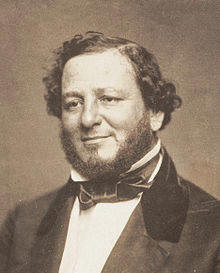
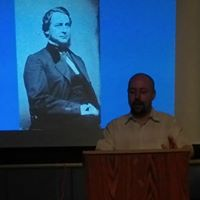

Our July meeting was our 425th. Attendance was 11. We had $2,229.23 in the bank, and
$35 to be deposited. There were no outstanding bills. Our
membership was 30. Three new members were in attendance.
Our speaker was our own Lee Hodges, Secretary of the
BCWRT. Lee spoke on the life and career of Judah P. Benjamin,
who served successively as Attorney General, Secretary of War,
and Secretary of State in the cabinet of Jefferson Davis.
Benjamin was born on August 6, 1811 on the island of St.
Croix in the Danish West Indies (today the U.S. Virgin Islands).
His parents were Jewish shopkeepers from London. The family
struggled to make a living, immigrating to the U.S. and
eventually settling in Charleston, S.C. At the age of 14,
Benjamin went to Yale University, only to leave during his
junior year for reasons that remain unclear. He then moved to
New Orleans and began studying law. He became a brilliant
lawyer, and by the age of 35 was considered THE commercial
lawyer of New Orleans. In 1842, he represented insurance
companies being sued for the value of slaves who had escaped in
the
Creole
slave revolt. In one of his briefs to the Louisiana
Supreme Court, Benjamin spoke eloquently of the humanity of
slaves in language strikingly reminiscent of Shylock’s famous “I
am a Jew” speech in Shakespeare’s
The Merchant of Venice.
On February 16, 1833, Benjamin married Natalie St.
Martin--a French Creole, Catholic woman. The pair had an
unusual marriage, with Natalie moving with their daughter to
Paris in 1845 and Judah visiting them about once a year. In
1844, Benjamin became the co-owner of Bellechasse, a sugar
plantation. He was elected to the Louisiana House of
Representatives in 1842, to the state Senate in 1851, and to the
U.S. Senate in 1852 and again in 1858. In the Senate, Benjamin
was greatly respected for his intelligence and skill as an
orator. He defended slavery, but on legal and constitutional
grounds rather than arguing that African Americans were inferior
or that slavery was the will of God.
When Louisiana left the Union, Benjamin resigned from the
Senate. He was soon chosen by Jefferson Davis to be his
attorney general. As Attorney General, Benjamin did not have
any landmark legal decisions to make. In September 1861, he
became acting Secretary of War, and in November was given a full
appointment to the position. Benjamin’s tenure as Secretary of
War was tumultuous. While he did a good job getting the
department to run efficiently and alleviating shortages, he also
got into arguments with generals including “Stonewall” Jackson,
with Jackson almost resigning from the army as a result. After
the loss of Roanoke Island in February 1862, Benjamin received
huge criticism, although the public didn’t know that he had
agreed to act as a scapegoat rather than admit the Confederacy’s
shortage of ammunition and supplies. As a result, Davis
transferred him to the State Department, and he became Secretary
of State on March 18, 1862.
As Secretary of State, Benjamin tried in vain to get
Britain and France to recognize the Confederacy and to get the
Union blockade lifted. However, he did manage to secure a major
loan for the Confederacy. He also supervised the Confederate
Secret Service, including missions conducted from Canada. On
February 9, 1865, he gave a major speech advocating the freeing
of any slave who would fight for the Confederacy (Irish-born
General Patrick Cleburne, who had settled in Arkansas in 1850,
had made a similar proposal). On March 13, the Confederate
Congress narrowly passed a bill authorizing African American
enlistments, but it fell short of Benjamin’s plan, emancipation
not being given to those who served.
Benjamin and Davis had not been close before the war—in
fact, they almost fought a duel in 1858. However, during the
war Benjamin became Davis’s right hand man, working 10 to 12
hours a day with him.
After the fall of the Confederate government, Benjamin
pulled off a daring escape from Florida to Britain. Several
times he narrowly avoided death or capture. In Britain he had
an extremely distinguished career as a barrister, becoming one
of the leading members of the British bar. He died on May 6,
1884.
Benjamin was apparently the first openly Jewish person to
serve in the U.S. Senate. The effect of his Jewishness on his
public career was mixed. On the one hand, being Jewish was not
a major obstacle to his advancement, including his selection to
the Confederate Cabinet. On the other hand, he was the target
of anti-Semitic attacks from critics in both the Confederacy and
the Union.
|
Meeting: June 25, 2019
|
Our speaker this month will be
former BCWRT President Bob Mullauer.
Bob Mullauer will take in in-depth look at
Abraham Lincoln and the Emancipation
Proclamation and the 13th Amendment
of the Constitution of the United States. This
is a timely topic with the recent celebration of
Juneteenth
(Juneteenth, also known as Juneteenth
Independence Day or Freedom Day, is an American
holiday that commemorates the June 19, 1865,
announcement of the abolition of slavery in the
U.S. state of Texas, and more generally the
emancipation of enslaved African Americans
throughout the former Confederate States of
America.)
President Abraham Lincoln issued the
Emancipation Proclamation
in September, 1862 (effective January 1, 1863)
which declared
"that all persons held as slaves" within the
rebellious states "are, and henceforward shall
be free." It also allowed for the recruitment
for Black men into the U.S. Army. Lincoln, aware
the act was a war measure which would cease upon
the end of the war, fought hard for the passage
of the more permanent
13th Amendment.
Bob Mullauer was
a high school history teacher for over a decade.
He currently teaches night-time courses at Anne
Arundel Community College as well as speaks to a
variety of groups on topics such as the American
Civil War in the Western Theater, World War II
in the Pacific, and the Napoleonic Wars. He has
led United States Army officers on staff rides
over the Chickamauga and Chattanooga
battlefields. Besides Civil War battlefields,
his travels include tours of World War II
battlefields in the Pacific as well as Normandy,
the Bulge, Verdun, and various Napoleonic sites
in Europe.
Notes from the President June 2019
Summertime, and the living is BUSY!!! There are
many Civil War related activities scheduled for
the summer. Reenactments, living history
showcases and simple visits to many of the Civil
War sites in the area should be added to your
calendars. I’ve already been ‘in uniform every
weekend this month. In fact, if someone wishes
to organize a trip for the BCWRT, please contact
me.
On June 25, we welcome back to the podium former
BCWRT President Bob Mullauer as he explores
Abraham Lincoln and the Emancipation
Proclamation and the 13th Amendment
of the Constitution of the United States.
Baltimore Civil War Roundtable Secretary Lee
Hodges will look into the life of Judah P.
Benjamin at our July 23 meeting. Benjamin
was successively Attorney General, Secretary of
War and Secretary of State in CSA president
Jefferson Davis's cabinet.
Most CW enthusiast know there is a Dunker church
on the Antietam battlefield. Few know anything
about the history of the church and their
members. Authors
Alann D. Schmidt and Terry W. Barkley will
alleviate that situation as they discuss their
new book;
September Mourn: The Dunker Church of Antietam.
This will be our August 27 meeting.
Staying with the Civil War in Western Maryland: Many
people are familiar with the highly circulated
picture of CSA soldiers marching through
Frederick, Maryland circa July, 1864. Our
September 24 meeting features Civil War
photography researchers Erik Davis and Paul
Bolcik will present their modern research on
"Frederick, MD and its famous Confederate
photo".
Our October 22 meeting has BCWRT
President Robert L. Ford conducting a
presentation on Christopher Lyle McIlwain, Sr,’s
book
The Million-Dollar Man Who Helped Kill a
President: George Washington Gayle and the
Assassination of Abraham Lincoln.
On November 26, Frederick
County CWRT Secretary and owner of Dyson Genealogy and Historical Research
Gary L. Dyson returns to BCWRT to discuss his
book "A
Civil War Correspondent in New Orleans".
The book tells the story of Boston Journal
correspondent Albert Gaius Hill as he covered
the New Orleans campaign of 1862.
Local
American History author Cory M. Pfarr will
reflect on his latest work
Longstreet at Gettysburg: A Critical
Reassessment during
our meeting on December 10.
Reminder: Membership has it’s privileges…and
joys. Urge your friends to join the Baltimore
Civil War Roundtable. Also, renew
you membership if you haven’t already paid your
annual dues.
|


Minutes -
Our June meeting was our 424th. Attendance was 14, and we had one visitor, a former
member. We had $2,244.23 in the bank. Our membership was 26.
Robert suggested that we organize a trip to a Civil
War-related place, like we used to in the past.
Our speaker was our own Bob Mullauer, former President of
the BCWRT. Bob spoke on the Emancipation Proclamation. When
Lincoln decided to issue the proclamation, the war was not going
well. He decided that the Union had to “change tactics or lose
the game.” Although Lincoln was strongly morally opposed to
slavery, this was not why the proclamation was issued—it was
issued as a war measure. On its face, the proclamation was a
rather strange document. The overwhelming majority of the
slaves it applied to were NOT under Union control, while those
who lived in Union- controlled areas were largely exempt from it
(the slaves in the border states, for example, weren’t affected
by it). Although this was counterintuitive, it was done because
at the time slavery was protected by the Constitution. Lincoln
was not a dictator—he couldn’t just end slavery everywhere at
will.
Prior to the proclamation, several generals, including
David Hunter, had issued their own proclamations freeing slaves.
But Lincoln voided these because he said generals didn’t have
the authority to issue them—only he, as president, had such
power.
Lincoln was a determined person. He wanted to hear the
opinions of cabinet members concerning the proclamation, so he
discussed the issue at cabinet meetings. But once he made up
his mind, he was determined to do it. However, he decided he
needed a victory before he could issue it. As a result, he
decided to put it off, while continuing to work for gradual
emancipation and colonization. He tested the waters by writing
a letter to Horace Greeley in which he said if he could free all
the slaves, none of them, or some of them to preserve the Union,
he would do so (while also making clear that he wanted all
people to be free). On September 22, five days after Antietam,
Lincoln issued the preliminary proclamation. The text is very
dry. He makes it clear that the purpose of the document is to
get the Confederate states back into the Union. He never
officially says that they left. The final proclamation was
issued on January 1, 1863.
The reaction was very mixed. While the proclamation
helped the Democrats, the Republicans held on to both houses of
Congress. There were celebrations in every major city.
Thaddeus Stevens didn’t say anything (a good thing from him).
On the other hand, it undermined pro-Union sentiment in the
Confederacy, at least temporarily. Border state leaders didn’t
like it, and it strengthened the peace element in the Democratic
party. The British prime minister, Lord Palmerston, said that
it was “trash” and proof that the federal government was
powerless. By February 1863, about 200,000 slaves had been
freed, according to Lincoln and Seward.
|
Meeting: May 28, 2019
|
History Professor and author Janet Croon has
recently edited and annotated
A Son of Georgia: The Civil War Journals of
LeRoy Wiley Gresham, 1860-1865. Gresham was an
12 years old invalid in Georgia who
began keeping a journal in 1860—just before
secession and Civil War tore the country and his
world apart. He continued to write even as his
health deteriorated until both the war and his
life ended in 1865.
Prof. Croon will take a detailed look at the
above book when she appears for the Baltimore
Civil War Roundtable (BCWRT) at our next meeting
on Tuesday, May 28, 2019 at the Parkville Senior
Center,
8601 Harford
Rd,
Parkville,
MD 21234.
The meeting begins at 7:30 p.m.
Janet Croon has recently retired from teaching
advanced high school history in Fairfax County,
Virginia. Originally from the Chicago area, she
has lived in several places, including Dayton,
OH, Albuquerque, NM, and Wiesbaden, Germany
before eventually ending up in the Northern
Virginia suburbs.
She holds degrees from
the University of Illinois (BA '83) in Political
Science, Modern European History, and Russian
Language and Area Studies and the University of
Dayton (MA '85) in International Relations.
(This was all very handy when living in Germany
in 1989 when the Berllin Wall came down!) She
began teaching World History and Twentieth
Century Topics in the International
Baccalaureate Programme, for which she also did
some contract work as a program moderator and
student paper examiner.
The love for the
Civil War came almost by accident, finding out
that she was working with her lawyer on her
divorce papers in the former home of a
Confederate female spy, and then reading a book
about that same spy's friend a number of years
later. (More books on this to follow...)
With two grown daughters successfully launched,
Jan spends a lot of her spare time knitting,
cross-stitching, watching Cubs baseball, and
enjoying the history of the area once occupied
by either Blue or Grey for the entirety of the
Civil War. Her black cat, Kittn, supervises.
Notes from the President May 2019
I wish to thank all the members of the
Chesapeake Civil War Roundtable and the
Baltimore Civil War Roundtable for their
commitment in making the April banquet with
author Noah Andrea Trudeau a great affair.
Positive comments have been received about
everything from the speaker’s presentation to
the food (thanks to the Columbus Garden’s
staff). Perhaps we can make this an annual joint
event.
On May 28, History Professor and author Janet
Croon will speak on her recently edited and
annotated
A Son of Georgia: The Civil War Journals of
LeRoy Wiley Gresham, 1860-1865. Gresham was an
12 years old invalid in Georgia who
began keeping a journal in 1860—just before
secession and Civil War tore the country and his
world apart. There is an article on the new book
in
The Old Liner in
the August News Articles link at the bottom of
the page.
We welcome back to the podium former
BCWRT President Bob Mullauer as he explores
Abraham Lincoln and the Emancipation
Proclamation and the 13th Amendment
of the Constitution of the United States. This
will be our June 25 meeting.
Baltimore Civil War Roundtable Secretary Lee
Hodges will look into the life of Judah P.
Benjamin at our July 23 meeting. Benjamin
was successively Attorney General, Secretary of
War and Secretary of State in CSA president
Jefferson Davis's cabinet.
Most CW enthusiast know there is a Dunker church
on the Antietam battlefield. Few know anything
about the history of the church and their
members. Authors
Alann D. Schmidt and Terry W. Barkley will
alleviate that situation as they discuss their
new book;
September Mourn: The Dunker Church of Antietam.
This will be our August 27 meeting.
Staying with the Civil War in Western Maryland: Many
people are familiar with the highly circulated
picture of CSA soldiers marching through
Frederick, Maryland circa July, 1864. Our
September 24 meeting features Civil War
photography researchers Erik Davis and Paul
Bolcik will present their modern research on
"Frederick, MD and its famous Confederate
photo".
Our October 22 meeting has BCWRT
President Robert L. Ford conducting a
presentation on Christopher Lyle McIlwain, Sr,’s
book
The Million-Dollar Man Who Helped Kill a
President: George Washington Gayle and the
Assassination of Abraham Lincoln.
On November 26, Frederick
County CWRT Secretary and owner of Dyson Genealogy and Historical Research
Gary L. Dyson returns to BCWRT to discuss his
book "A
Civil War Correspondent in New Orleans".
The book tells the story of Boston Journal
correspondent Albert Gaius Hill as he covered
the New Orleans campaign of 1862.
Local
American History author Cory M. Pfarr will
reflect on his latest work
Longstreet at Gettysburg: A Critical
Reassessment during
our meeting on December 10.
Reminder: Membership has it’s privileges…and
joys. Urge your friends to join the Baltimore
Civil War Roundtable. Also, renew
you membership if you haven’t already paid your
annual dues.
|

 
AWARD NOTICES: Several have come in for 2018 (they seem a bit
late this year), and several more are due in within two weeks.
To kick things off, we are very pleased to announce that "The
War Outside my Window: The Civil War Diary of LeRoy Wiley
Gresham, 1860-1865," Janet E. Croon, editor, was a FINALIST in
the Indie Book Awards for Memoirs. Given that there are
thousands of books submitted, and only five finalists in each
category, this a very high honor indeed. Congrats, Jan!
LeRoy's Diary is nearly sold through its third printing, Jan is
on her third Georgia tour right now, and the accompanying
Teacher's Guide is in galley and will be available within a
couple months.
Thank you to everyone for your support, your reviews, and your
word-of-mouth help in making this possible. It is truly one of
the most remarkable projects I have ever had the privilege of
helping edit and publish.
Savas Beatie, LLC
Publisher
Minutes
Our May meeting was our 423rd.
Attendance was 11. As of May 26th,
we had $2,359.23 in the bank and no outstanding bills. Our
membership was 26.
Our speaker was Janet Elizabeth Croon. Ms. Croon, a history
teacher and author, discussed the diary kept during the Civil
War by LeRoy Wiley Gresham, a boy from Georgia, from 1860 until
the war’s end in 1865. Ms. Croon is the editor of
The War Outside My Window: The Civil War Diary of LeRoy Wiley
Gresham, 1860-1865.
LeRoy was born on November 11th,
1847 to a prominent Georgia slave-holding family. His father
was elected mayor of Macon twice. In 1856, a falling chimney
crushed LeRoy’s leg. He was never able to walk again, and as a
result was often pulled in a wagon by a slave, a friend, or his
brother. He developed a cough by 1857, and back abscesses by
1860. It turned out that he was terminally ill with a rare form
of tuberculosis known as Pott’s disease. However, he was never
told this. He died on June 18th,
1865.
An educated and highly intelligent boy, LeRoy received his diary
as a gift from his mother. The diary is remarkable for several
reasons. It is the only known account from the war by a teenage
male non-combatant, the only known “insider’s view” of a
prominent Southern family during the war, and the only known
diary in the world dealing with the course and treatment of
tuberculosis in the 19th century.
LeRoy was inquisitive, sweet, funny, talkative, and kind. He
followed the war very closely, and his diary provides insights
that cannot be found elsewhere. For example, he says that the
blockade began affecting civilians a year before the history
books say it did. Also, he uses names for battles that are not
mentioned in Civil War books today. LeRoy learned that not
everything he read was true. His diary allows us to see how
civilians processed slow—and often incorrect---news.
LeRoy was happy about secession. He loved Jefferson Davis,
although his support for Davis waned by the end of the war. On
the other hand, he despised Georgia governor Joseph E. Brown,
saying that Brown’s rule was like living under a dictatorship.
LeRoy mocked Lincoln and Union soldiers, which was a common
thing to do. His views during the first year of the conflict
probably reflected his father’s.
LeRoy was very interested in how Georgia troops were doing at
the front. His father was in the home guard. Sherman’s
campaign is well covered in the diary. LeRoy doesn’t discuss
slavery, although he does describe how plantation crops
supported the family home. He was born into a slave society,
and never knew anything else. There were 93 slaves on the
Gresham plantations, and eight in the Macon household. LeRoy
mentions many of them by name—he obviously felt affection for
them.
When Confederate defeat became imminent, Leroy became depressed.
At the same time, the pain he suffered was becoming horrendous.
He had to take more morphine to relieve it. He was also
becoming weaker, with his “good” leg beginning to draw up and
becoming useless. Near the end of the diary, his mother’s
handwriting begins to replace his own. His last entry is from
June 9th,
nine days before he died.
In the end, Leroy’s chronicle of the demise of the Old South
eerily paralleled his own decline and death.
|
Meeting: April 23, 2019
|
March 1865: The United States was at a
crossroads and, truth be told,
Abraham Lincoln was
a sick man. “I am very unwell,” he confided to a
close acquaintance. A vast and terrible civil
war was winding down, leaving momentous
questions for a war-weary president to address.
A timely invitation from General U. S. Grant
provided the impetus for an escape to City
Point, Virginia, a journey from which Abraham
Lincoln drew much more than he ever expected.
Lincoln’s Greatest Journey: Sixteen Days that
Changed a Presidency, March 24 – April 8, 1865,
by Noah Andre Trudeau
offers the first comprehensive account of a
momentous time.
Lincoln traveled to City
Point, Virginia, in late March 1865 to escape
the constant interruptions in the nation’s
capital that were carrying off a portion of his
“vitality,” and to make his personal amends for
having presided over the most destructive war in
American history in order to save the nation.
Lincoln returned to Washington sixteen days
later with a renewed sense of purpose, urgency,
and direction that would fundamentally shape his
second term agenda
Mr. Trudeua will reveal the details of Lincoln’s
journey when he speaks to the Baltimore Civil
War Roundtable (BCWRT) and the Chesapeake Civil
War Roundtable (CCWRT) at our joint banquet on
Tuesday, April 23, 2019. The banquet will be
held at the Columbus Gardens, 4301 Klosterman
Ave, Baltimore (Nottingham), Maryland 21236. The
Cocktail Hour begins at 6 p.m. with the Dinner
starting at 7 p.m. Ticket are $35.00 per person.
See the flyer link for more details.
Notes from the President April 2019
Our Annual Banquet is almost upon us! Noted
Civil War Historian and author Noah Andre
Trudeau will be the banquet speaker, which will
again we held at Columbus Gardens on April 23,
2019. Mr. Trudeau’s topic will center on his
latest book: Lincoln’s
Greatest Journey: Sixteen Days That Changed a
Presidency, March 24-April 8, 1865.
We will be joined by the Chesapeake Civil War
Roundtable in presenting this event.
Tickets are $35.00. Cocktail hour begins at 6
p.m. with dinner beginning at 7 p.m. Please see
the flyer listed below.
On May 28, History Professor and author Janet
Croon will speak on her recently edited and
annotated
A Son of Georgia: The Civil War Journals of
LeRoy Wiley Gresham, 1860-1865. Gresham was an
12 years old invalid in Georgia who
began keeping a journal in 1860—just before
secession and Civil War tore the country and his
world apart. There is an article on the new book
in
The Old Liner in
the August News Articles link at the bottom of
the page.
Baltimore Civil War Roundtable Secretary Lee
Hodges will look into the life of Judah P.
Benjamin at our July 23 meeting. Benjamin
was successively Attorney General, Secretary of
War and Secretary of State in CSA president
Jefferson Davis's cabinet.
Most CW enthusiast know there is a Dunker church
on the Antietam battlefield. Few know anything
about the history of the church and their
members. Authors
Alann D. Schmidt and Terry W. Barkley will
alleviate that situation as they discuss their
new book;
September Mourn: The Dunker Church of Antietam.
This will be our August 27 meeting.
Staying with the Civil War in Western Maryland: Many
people are familiar with the highly circulated
picture of CSA soldiers marching through
Frederick, Maryland circa July, 1864. Our
September 24 meeting features Civil War
photography researchers Erik Davis and Paul
Bolcik will present their modern research on
"Frederick, MD and its famous Confederate
photo".
On November 26, Frederick
County CWRT Secretary and owner of Dyson Genealogy and Historical Research
Gary L. Dyson returns to BCWRT to discuss his
book "A
Civil War Correspondent in New Orleans".
The book tells the story of Boston Journal
correspondent Albert Gaius Hill as he covered
the New Orleans campaign of 1862.
Local
American History author Cory M. Pfarr will
reflect on his latest work
Longstreet at Gettysburg: A Critical
Reassessment during
our meeting on December 10.
Our July and October meetings are still being
finalized.
Reminder: Membership has it’s privileges…and
joys. Urge your friends to join the Baltimore
Civil War Roundtable. Also, renew
you membership if you haven’t already paid your
annual dues.
|
 
***April 23, 2019 Banquet Flyer***
2019 Banquet Pictures
Minutes
Our April meeting was our 422nd and
was our Annual Banquet. The banquet was attended by members of
both the Baltimore Civil War Roundtable and the Chesapeake Civil
War Roundtable. Our speaker was Noah Andre Trudeau. Mr.
Trudeau discussed Abraham Lincoln’s stay at City Point,
Virginia, in late March and early April of 1865. He is the
author of
Lincoln’s Greatest Journey: Sixteen Days that Changed a
Presidency, March 24—April 8, 1865.
Mr. Trudeau explained in detail the detective work that he had
to do in order to make sure that his account of Lincoln’s time
at City Point was accurate. The sources had to be examined
critically and did not always check out. For example, his
research led him to conclude that the account of William H.
Crook, published in 1895, was inaccurate. Mr. Trudeau also
discussed the reliability of accounts by three people who spent
time with Lincoln—John Sanford Barnes, captain of the USS
Bat,
which was assigned to provide security for the president, Samuel
H. Beckwith, Grant’s main telegrapher, who also served as
Lincoln’s personal telegrapher from March 29th to
April 8th,
and Charles Penrose, a commissary specialist who accompanied the
president. Penrose, according to Mr. Trudeau, was the most
problematic source of the three.
Lincoln’s being at City Point was not big news at the time.
During the early morning of March 25th, while
Lincoln was spending his first night sleeping there, the
Confederates launched a surprise attack. The Army of the
Potomac did a great job of repelling it, and later that day
Lincoln reviewed the troops. Grant went to the front on March
29th,
but rain slowed his progress. By the 31st,
Lincoln realized that the end of the war was much closer than it
seemed. So he decided to hang around City Point.
The 31st was,
according to Mr. Trudeau, a major day in Lincoln’s presidency.
Originally, the War Department left it to the press to provide
battle summaries. But then they decided to provide annotated
summaries themselves. Lincoln personally annotated war
bulletins and continued to do so over the next few days. These
had a seismic effect on the nation—they were referred to in the
newspapers with glowing headlines, such as “The President to the
People.” It was said that they had as big an effect as the
Emancipation Proclamation. They were clearly important.
Lincoln reached Richmond on April 4th.
Contrary to what was claimed by Bill O’Reilly, he did not land
at Rockett’s Wharf, but at 17th and
Dock Streets, a mile west of Rockett’s. During his initial
coming ashore, Lincoln was not received as if he were Jesus.
There was a lot of anxiety among those guarding him, and the
crowds were small. The logbook of the USS
Malvern
shows that a group of Marines was detached to accompany him.
According to Mr. Trudeau, Lincoln was probably mobbed by
African Americans on April 5th,
rather than the 4th.
On April 8th,
Lincoln went to the Depot Field Hospital to personally visit
5-6,000 wounded soldiers. He was originally directed toward one
of the kitchens, but he said he came to “…take by the hand the
men who have achieved our glorious victories.” For four to five
hours, he touched them—including those in the tent who were too
sick to come out. He treated the wounded Confederates who were
there the same way. This was, according to Mr. Trudeau, a
profound moment of his presidency.
|
Meeting: March 26, 2019
|
After the last battles and army demobilizations
of the Civil War, the long period of rebuilding
the USA began. Under the presidency of Andrew
Johnson, the political infighting along with
terrorism, riots, land grabs, etc. made the
country seemingly almost as tumultuous as during
the war itself. During this chaos, the
administration of U.S. Grant emerged.
In The
Presidency of Ulysses S. Grant: Preserving the
Civil War’s Legacy,
historian Paul Kahan focuses on the unique
political, economic, and cultural forces
unleashed by the Civil War and how Grant
addressed these issues during his tumultuous two
terms as chief executive. A timely
reassessment, The Presidency of Ulysses S.
Grant sheds new light on the business of
politics in the decade after the Civil War and
portrays an energetic and even progressive
executive whose legacy has been overshadowed by
both his wartime service and his
administration’s many scandals.
Dr. Paul Kahan is an expert on the political,
diplomatic, and economic history of the United
States in the nineteenth century. He earned a
Ph.D. in U.S. history from Temple University.
Prior to that, Dr. Kahan earned an M.A. in
Modern American History & Literature from Drew
University and B.A.s in history and English from
Alfred University.
Dr. Kahan has published several other books,
including "Eastern State Penitentiary: A
History," "Amiable Scoundrel: Simon Cameron,
Lincoln's Scandalous Secretary of War," and "The
Bank War: Andrew Jackson, Nicholas Biddle, and
the Fight for American Finance."
The Baltimore Civil War Roundtable will host Dr.
Kahan’s presentation on Grant’s presidency on
Tuesday, March 26, 2019 at the Parkville Senior
Center,
8601 Harford Rd, Parkville, Md. 21234. The
meeting begins at 7:30 p.m.
Notes from the President March 2019
Spring is here (at least according to the
calendar). Just like the fighting armies
emerging from winter quarters some 154 years
ago, it’s time to Civil War enthusiasts to
traverse Civil War sites, visit museums and
attend BCWRT functions!
Our Annual Banquet is almost upon us! Noted
Civil War Historian and author Noah Andre
Trudeau will be the banquet speaker, which will
again we held at Columbus Gardens on April 23,
2019. Mr. Trudeau’s topic will center on his
latest book: Lincoln’s
Greatest Journey: Sixteen Days That Changed a
Presidency, March 24-April 8, 1865.
We will be joined by the Chesapeake Civil War
Roundtable in presenting this event.
Tickets are $35.00. Cocktail hour begins at 6
p.m. with dinner beginning at 7 p.m. Please see
the flyer listed below.
March 26, 2019 at 7:30 p.m. is the date and time
for our next monthly meeting.
Historian Dr. Paul Kahan will focus on the
Reconstruction period utilizing his latest book; The
Presidency of Ulysses S. Grant: Preserving the
Civil War's Legacy
for our March 26 meeting.
On May 28, History Professor and author Janet
Croon will speak on her recently edited and
annotated
A Son of Georgia: The Civil War Journals of
LeRoy Wiley Gresham, 1860-1865. Gresham was an
12 years old invalid in Georgia who
began keeping a journal in 1860—just before
secession and Civil War tore the country and his
world apart. There is an article on the new book
in
The Old Liner in
the August News Articles link at the bottom of
the page.
Baltimore Civil War Roundtable Secretary Lee
Hodges will look into the life of Judah P.
Benjamin at our July 23 meeting. Benjamin
was successively Attorney General, Secretary of
War and Secretary of State in CSA president
Jefferson Davis's cabinet.
Most CW enthusiast know there is a Dunker church
on the Antietam battlefield. Few know anything
about the history of the church and their
members. Authors
Alann D. Schmidt and Terry W. Barkley will
alleviate that situation as they discuss their
new book;
September Mourn: The Dunker Church of Antietam.
This will be our August 27 meeting.
Please see our Calendar of Events link to see
additions meetings for 2019.
It is time to renew you membership in the
Baltimore Civil War Roundtable. Please renew
today. Additionally, encourage the Civil War
interest in your family and friends by having
them join. Let them know what they are missing!
|
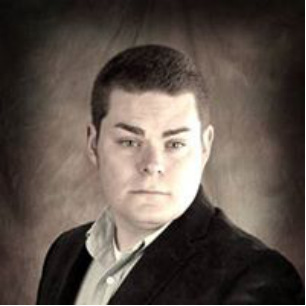
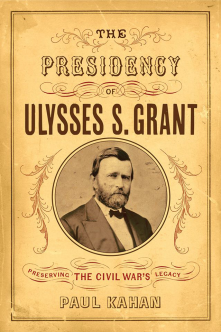
Pictures from meeting, click to enlarge...

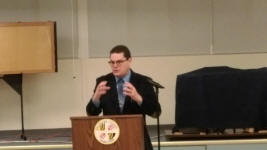
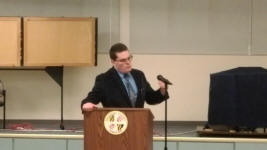
Our March meeting was our 421st.
Our attendance was 17. We had $2,438 in the bank, and another
$315 to be deposited. We had one visitor, who became a member.
We had only 23 people signed up as members. 87 people on lists
from previous years were not signed up.
Our speaker was Dr. Paul Kahan. Dr. Kahan discussed Ulysses S.
Grant’s presidency. He is the author of
The Presidency of Ulysses S. Grant: Preserving the Civil War’s
Legacy.
Dr.
Kahan argued that although Grant was not a great president, he
was not a bad one either. Moreover, Grant’s presidency was an
important one in American history. Dr. Kahan noted that Grant
himself was quite dissatisfied with his presidency. In his
final message to Congress, Grant acknowledged that much had not
gone well, a very unusual admission for a president. Moreover,
his memoirs end in 1865, as if he had never become president at
all.
When Grant was president, the chief issue before the nation was
Reconstruction. Reconstruction was, according to Dr. Kahan, the
Civil War by other means. It was a thorough political and
cultural transformation of the South. At the end of the war, he
noted, the South was not “destroyed” like, for example, Nazi
Germany was at the end of WWII. There was no clear plan for
Reconstruction when Lincoln was assassinated. Although
Republicans became extremely dissatisfied with President Andrew
Johnson’s lenient policies toward the South, they needed someone
to rally around. Grant was their man—he was the most popular
person in the North at the time. In 1868, he was elected
president, and was reelected in 1872.
Grant had some notable accomplishments as president. He did a
great deal to protect the rights of African Americans in the
South. The Ku Klux Klan was effectively destroyed. The
Department of Justice was created, and the Treaty of Washington
paved the way for the “special relationship” between the U.S.
and Britain. Additionally, violent conflict with Native
Americans was substantially reduced.
In his second term, however, difficulties began to multiply.
There was the Panic of 1873—known as the “Great Depression”
before the 1930s. Corruption scandals erupted--although Grant
was not personally corrupt, and his administration was far from
unique in this regard. As the years went by, Grant had fewer
and fewer troops to garrison the South, and support for
protecting African American rights diminished in the North.
Grant’s Native American policies also began to crumble—for
example, gold was discovered in the Black Hills of South Dakota,
resulting in whites trampling on land promised to the Natives.
Dr. Kahan argued that Grant made mistakes in three principal
areas. He naively believed he could be above politics (Simon
Cameron, former Secretary of War under Lincoln, turned out to be
a key Grant ally as a U.S. senator from Pennsylvania). His
desire to annex Santo Domingo was misguided—he envisioned it as
a sort of “quick fix” for America’s racial problems, a place
where African Americans could move to. Grant also made mistakes
regarding economic policies.
Dr. Kahan ended by asking the question: Why was Grant’s
presidency viewed so negatively in the past? He ascribed this
to the growth of the Lost Cause narrative, whose viewpoint can
be seen in the famous films
The Birth of a Nation
and
Gone with the Wind.
Grant was believed to have pushed too hard on Reconstruction.
During the 1960s, as a result of the civil rights movement,
historical views of Reconstruction began changing drastically.
However, this did not immediately help Grant, for the period
was now seen as a series of missed opportunities. It wasn’t
until the 1990s that Grant’s papers became published, and
largely because of them, historians now view his presidency much
more favorably than before. He wasn’t Lincoln but, according to
Dr. Kahan, neither was he James Buchanan.
|
Meeting: February 26, 2019
|
The term
Freemasonry concerns
the teachings and practices of the secret
fraternal order officially known as the
Free and Accepted Masons, or Ancient Free and
Accepted Masons.
There are over 5 million members in the world
today, mainly in the United States and other
English –speaking countries.
Masonry was
quite prominent during the Civil War, having
started with the first colonial lodge in
Philadelphia in 1730.
Benjamin Franklin,
John Hancock,
Paul Revere
and George Washington were among the
revolutionary leaders who became masons.
Since
membership in masonic lodges existed throughout
the United States, it produced a unique
relationship among masons on both sides of the
North/South conflict.
Charles Matulewicz,
Past Worshipful
Master and current Fraternal Visitation Chairman
at the
Palestine Masonic Lodge #189 (Catonsville) will
talk about Masonry during the Civil War in is
presentation to the Baltimore Civil War
roundtable on Tuesday, February 23.
In addition to his leadership roles with his
lodge,
Mr. Matulewicz has
a leadership role in Trace International, Inc.,
billed as the ’Global Leader in Anti-Bribery
Standard Setting and Shared Cost Compliance
Solutions. He is the former Vice President of
Sales of triCerat, Inc. He also serves on
several non-profit boards focused on community
service and child welfare. He attended the MBA
program at Texas A&M University and holds a
Bachelor of Arts from Temple University.
Mr. Matulewicz’s BCWRT presentation will be on
Tuesday, February 23, 2019 at the Parkville
Senior Center,
8601 Harford Rd, Parkville, Md. 21234.
Notes from the President February 2019
The Encyclopedia Brittanica describes
Freemasonry as,”
the teachings and practices of the secret
fraternal (men-only) order of Free and Accepted
Masons, the largest worldwide secret society.
Spread by the advance of the
British Empire,
Freemasonry remains most popular in the
British Isles and
in other countries originally within the
empire……Freemasonry evolved from the
guilds of
stonemasons and cathedral builders of the
Middle Ages.
With the decline of cathedral building, some
lodges of operative (working) masons began to
accept honorary members to
bolster their
declining membership. From a few of these lodges
developed modern symbolic or speculative
Freemasonry, which particularly in the 17th and
18th centuries adopted the rites and trappings
of ancient religious orders and of chivalric
brotherhoods.”
Freemasonry played an important role in the
lives of many Union and Confederate men, from
officers to enlisted men. Charles Matulewicz,
Past
Worshipful Master at the Palestine Masonic Lodge
#189 will provide insight into wartime masonry
at our February 26 meeting.
Noted Civil War Historian and author Noah Andre
Trudeau will be the speaker for the Annual
Banquet which will again we held at Columbus
Gardens on April 23, 2019. Mr. Trudeau’s topic
will center on his latest book: Lincoln’s
Greatest Journey: Sixteen Days That Changed a
Presidency, March 24-April 8, 1865.
Tickets are $35.00. Cocktail hour begins at 6
p.m. with dinner beginning at 7 p.m. Please see
the flyer listed below.
Historian Dr. Paul Kahan will focus on the
Reconstruction period utilizing his latest book; The
Presidency of Ulysses S. Grant: Preserving the
Civil War's Legacy
for our March 26 meeting.
On May 28, History Professor and author Janet
Croon will speak on her recently edited and
annotated
A Son of Georgia: The Civil War Journals of
LeRoy Wiley Gresham, 1860-1865. Gresham was an
12 years old invalid in Georgia who
began keeping a journal in 1860—just before
secession and Civil War tore the country and his
world apart. There is an article on the new book
in
The Old Liner in
the August News Articles link at the bottom of
the page.
Please see our Calendar of Events link to see
additions meetings for 2019.
It is time to renew you membership in the
Baltimore Civil War Roundtable. Please renew
today. Additionally, encourage the Civil War
interest in your family and friends by having
them join. Let them know what they are missing!
|
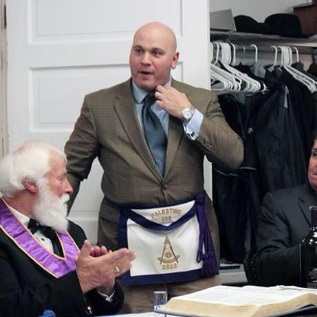
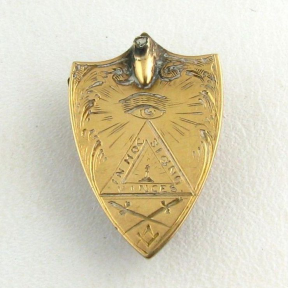
Charles Matulewicz
Civil War Era Soldier’s Masonic Pin
Pictures from
Meeting, click to enlarge picture >>>
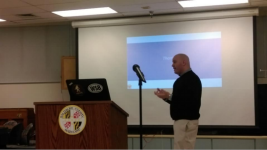
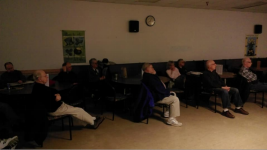
Charles
Matulewicz, Past Worshipful Master and current Fraternal
Visitation Chairman at the Palestine Masonic Lodge #189
(Catonsville) during his talk about Masonry during the Civil War
on Tuesday, February 23, 2019 — at
Parkville Senior Center.
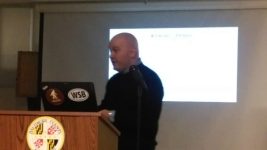
Our February meeting was our 420th.
Our attendance was 14. There was no treasurer’s report.
Our speaker was Charles Matulewicz, Past Worshipful Master and
current Fraternal Visitation Chairman at the Palestine Masonic
Lodge #189 in Catonsville. Mr. Matulewicz discussed Masonry in
the Civil War.
Freemasonry refers to the teachings and rituals of a secret
fraternal organization known as the “Free and Accepted Masons”
or “Ancient Free and Accepted Masons.” The organization is
believed to have its roots in medieval stonemason and cathedral
builder guilds. It began in what is now the United States
during the colonial period. While allegorical images are used
today, in colonial times Masons would draw images on the floor
in public spaces. A convention held in Baltimore in 1843
standardized the ritual nationwide. The records we have of
meetings during the Civil War are largely between the Grand
Lodges.
Mr. Matulewicz described Freemasonry as the LinkedIn and
Facebook of the Civil War period. It was a way for people to
have a loose social connection. A Mason could feel at home when
they were in a strange place—there would be other Masons they
could talk to. During the war, the institution served both
altruistic and practical ends. One Mason would take care of
another’s family members if something happened to them. Badges
existed which identified someone as a Mason. If a soldier was
killed, a fellow Mason could get the body home. The bonds
between Masons were sometimes displayed by those fighting on
opposite sides. It is estimated that about ten percent of the
armies were Masons, compared with only two percent of the
general population.
There are many beautiful stories concerning Masons in the war,
but most are anecdotal and difficult to prove. Brigadier
General Albert Pike is the only Confederate general to have a
statue in Washington DC, but it’s a Mason statue—Pike’s Civil
War service isn’t mentioned. According to Mr. Matulewicz, it is
a myth that Pike founded the KKK. Additionally, he said, John
Wilkes Booth was not a Mason.
|
Meeting:
January 22, 2019
|
Union Maj. Gen. William Tecumseh Sherman began
his Savannah Campaign on November 15, 1864.
Better known as Sherman’s March to the Sea, this
military movement is still discussed, debated,
and questioned about its effective and affective
to this present day.
University of Maryland History Professor Anne S.
Rubin
will explore various aspects this relatively
short campaign to Savannah, Georgia (it ended on
December 21, 1864), at the Baltimore Civil War
Roundtable meeting on January 22.
Anne Sarah Rubin’s presentation
uncovers and unpacks stories and myths about the
March from a wide variety of sources, including
African Americans, women, Union soldiers,
Confederates, and even Sherman himself. Drawing
her evidence from an array of media, including
travel accounts, memoirs, literature, films, and
newspapers, Rubin uses the competing and
contradictory stories as a lens into the ways
that American thinking about the Civil War have
changed over time.
A member of the UMBC History Department since
2000,
Prof. Rubin courses
focus on the American Civil War, the U.S. South,
nineteenth-century America, and digital history.
Her book,
Through the Heart of Dixie: Sherman’s March and
America, which
explores the way Americans have remembered
Sherman’s March, was published in 2014. Her
first book, A
Shattered Nation: The Rise and Fall of the
Confederacy, 1861-1868, won
the 2006 Avery O. Craven book prize for the best
book in Civil War history.
The book focuses on Confederate nationalism and
identity.
Prof. Rubin BCWRT presentation will be on
Tuesday, January 22, 2019 at the Parkville
Senior Center,
8601 Harford Rd, Parkville, Md. 21234.
Notes from the President January 2019
Happy New Year! It is my hope that all of you
will have a prosperous and joyous 2019. I also
hope that the Baltimore Civil War Roundtable
will have great speakers, larger monthly meeting
attendance, increased membership and wonderful
activities in 2019.
I’m happy to announce that the noted Civil War
Historian and author Noah Andre Trudeau will be
the speaker for the Annual Banquet which will
again we held at Columbus Gardens on April 23,
2019. Mr. Trudeau’s topic will center on his
latest book: Lincoln’s
Greatest Journey: Sixteen Days That Changed a
Presidency, March 24-April 8, 1865.
Tickets are $35.00. Cocktail hour begins at 6
p.m. with dinner beginning at 7 p.m.
We will begin our meetings for 2019 on Tuesday
January 22 with University of Maryland Baltimore
County (UMBC) History Professor Anne S. Rubin
speaking on her book
Through the Heart of Dixie: Sherman’s March and
American Memory.
The award winning Prof. Rubin teaches
courses on the Civil War, American South, and
the Nineteenth Century United States.
Freemasonry played an important role in the
lives of many Civil War men, from officers to
enlisted men. Charles Matulewicz,
Worshipful Master at the Palestine Masonic Lodge
will provide insight into wartime masonry at our
February 26 meeting.
Historian Dr. Paul Kahan will focus on the
Reconstruction period utilizing his latest book; The
Presidency of Ulysses S. Grant: Preserving the
Civil War's Legacy
for our March 26 meeting.
On May 28, History Professor and author Janet
Croon will speak on her recently edited and
annotated
A Son of Georgia: The Civil War Journals of
LeRoy Wiley Gresham, 1860-1865. Gresham was an
12 years old invalid in Georgia who
began keeping a journal in 1860—just before
secession and Civil War tore the country and his
world apart. There is an article on the new book
in
The Old Liner in
the August News Articles link at the bottom of
the page.
Please see our Calendar of Events link to see
additions meetings for 2019.
IMPORTANT REMINDER:
Remember, it’s time to renew your membership for
2018. Yearly
dues are $25.00 for an individual membership,
$35.00 for a family membership. Please give your
check to Ray Atkins or mail it to him using the
membership form found on our webpage.
(http://bcwrt.nalweb.net/default.htm.) We
are always looking for new members. Invite a
friend to our meetings. The BCWRT has many good
things happening. Please spread the word.
We
are always looking for new members. Invite a
friend to our meetings. The BCWRT has many good
things happening. Please spread the word.
Robert L. Ford,
President
|

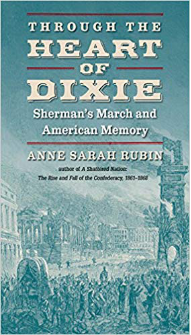
Minutes -
Our January meeting was our 419th.
Our attendance was 13. We had one guest—Bryan Cheeseboro, our
December speaker. As of December 11th,
we had $1,746.17 in the bank and $25 to be deposited.
Our speaker was Anne Sarah Rubin, Professor of History at UMBC.
Professor Rubin discussed her book entitled
Through the Heart of Dixie: Sherman’s March and American Memory.
She wrote the book because she wanted to know what kinds of
stories people have told about the march, and why they have told
them.
Over the decades, Sherman’s March has been a highly emotive
subject. As an example of this, Professor Rubin cited an event
which took place in 1963. John Lewis was to give a speech at
the Lincoln Memorial, as part of the March on Washington. As a
means of showing student frustration at the slow pace of change,
Lewis wanted to make a reference to the march, depicting the
students as an army breaking down segregation. That analogy,
however, was considered too provocative—even though, as Rubin
points out in her book, 99 years had passed since the march.
Lewis removed it before giving the speech.
Professor Rubin then discussed the nature of the march itself.
One big misconception is that there was a solid 50-mile front
of Union troops marching through Georgia. The truth is that 50
miles was only the distance between the extreme edges of the
four columns the men typically marched in. The army was more
like, in her words, “…rows of stitches, with untouched spaces in
between.” Furthermore, most antebellum homes were not destroyed
(most private homes in Atlanta had been left intact as well).
There were very few major engagements with Confederates during
the march. Sherman issued Special Field Orders No. 120, which
directed his men to “forage liberally on the country,” but not
to enter the homes of civilians, and to leave property alone if
the army was left “unmolested.” These orders were honored more
in theory than in practice. Sherman’s men behaved worse in
South Carolina than in Georgia because they blamed South
Carolina for the war.
Sherman was basically a white supremacist. Nevertheless, his
army effectively became an army of liberation for African
Americans in its path, freeing them from slavery. At the same
time, however, the treatment of African Americans by Sherman’s
men varied greatly and was sometimes very cruel.
Professor Rubin also discussed the memoirs of George Quimby,
which she has co-edited. Quimby was born in Ohio in 1842, and
enlisted in the 32nd Wisconsin
in 1862, at the age of 20. He served as a scout during the
march. His memoir is very valuable because there aren’t many
personal accounts by Union scouts. It should be noted that
scouts were not the same thing as spies. Scouts went out in
advance of the army, performing many important tasks. They
sometimes rode up to 70 miles a day. Quimby generally treated
civilians with respect. African Americans helped him a lot,
although it’s hard to gauge his attitude towards them from the
memoirs.
Professor Rubin’s conclusion was that there is no one story of
Sherman’s march. Instead, it’s like a kaleidoscope—there are
many different stories and points of view.
Click pictures to enlarge...

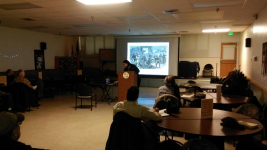
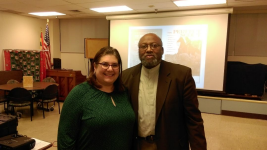
|
|




































